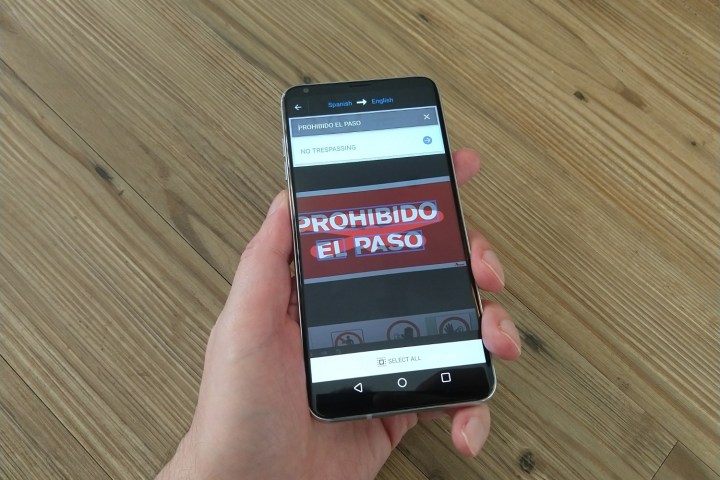
The vast majority of us don’t have that kind of time to dedicate to the study of a new language, especially if we’re gearing up for our next international adventure. We might arm ourselves with a few useful phrases like how to ask where the restroom is, and then turn to a translation app to help us out with the rest.
Translations apps aren’t perfect, but they’re certainly better than nothing. They’re improving all the time, and can be a valuable tool if you do decide to learn another language down the road. That being said, nothing beats actually learning a new language, but translation apps will get the job done (with only a handful of errors). Maybe one of these days Google will perfect its real-time translations earbuds and we won’t have the need to learn any more languages. But in the meantime, we’ve found the best translation apps.
Google Translate

Google Translate is one of the best apps out there for translation. Available on iPhone and Android, Google’s contest-winning translator can translate sentences between 103 different languages. It offers voice, image, and handwriting translations for many of those languages as well and can translate bilingual conversations on the fly. The app is completely free (no in-app purchases) and sets the bar high for accurate machine translations. It does have a few downsides, namely its inability to edit sentence translations as a whole (especially in languages like Chinese), but it’s easily one of the best translator apps out there. Currently, Google is working on implementing live translations into its latest pair of earbuds. If you want to know more, you can check the guide we created on how to use Google Translate.
iTranslate

There are a couple of different iTranslate apps on the market right now, including iTranslate Converse, iTranslate Voice, and iTranslate Translator. Like Google, the developers at iTranslate are trying to perfect a live translation service, called the Ear Translator. But we’re just going to talk about the flagship translator app, iTranslate Translator, for the moment. This app offers on- and offline translations for over 100 languages (16 offline). It’s compatible with the Apple Watch and there’s also an iMessage and iPhone keyboard extension, which makes it incredibly versatile. While the initial app is indeed free, it is ad-supported, and you’ll need to pay to subscribe to a Pro account to get the most out of the app. Depending on which package you choose (a month or a year), it will cost you about $3 to $5 a month to have the power of language at your fingertips.
Naver Papago Translate

Most translation apps have no problem translating Romance and other European languages, but often struggle to provide accurate translations of Asian languages. This is because most translation apps are created in the United States, where companies lack extensive data on languages like Chinese and Japanese. Papago, from Naver, the creator of Korea’s top search engine, only supports 10 languages, but provides better Asian language translations than its competitors. It offers many of the same features as the other apps, including text, voice, photo, and conversation translations. Based on its reviews, it suffers from inaccurate voice and photo recognition, but is the most accurate translation app for the languages it offers, and will likely only continue to get better.
Microsoft Translate

Microsoft Translator is — you guessed it — Microsoft’s take on a machine translator. It offers text, image, and voice translations for over 60 languages, all of which can be downloaded for offline use. You can also connect the app and translate multiperson conversations (although this doesn’t work with Windows Phone). Microsoft Translator has a phrasebook for verified translations and pronunciation guides that will help you learn important phrases while you’re traveling. It’s compatible with most smartwatches and devices, and if you connect the app between any of your own devices, it will automatically sync translations you have already made, ensuring that you don’t make the same translation over and over. Microsoft Translator is powered by the same technology used by Microsoft Office, Bing, and Twitter.
TripLingo

TripLingo takes a slightly different approach to translating than other apps like it. It offers the typical voice, image, and text translations, but also has four different slang levels for translations (formal versus informal), professionally recorded audio files, as well as a “culture crash course” to get you familiar with local customs and etiquette. It currently offers support for up to 42 languages. Another interesting feature of this app is that if a translation is not working or you still can’t understand its meaning, TripLingo will get you in touch with a live translator to help you out (for a fee). While this app is very cool, it’s unfortunately one of the most expensive. The base app is free and offers basic features for all of its languages, but in order to get the lessons, offline dictionary, and live translation services, you have to pay $20 per month for a subscription. Twenty bucks isn’t much considering how useful something like this could be on vacation, so it may be worth it.
Editors' Recommendations
- The best tablets in 2024: top 11 tablets you can buy now
- What is NFC? How it works and what you can do with it
- The best iPhone keyboard apps in 2024: our 12 favorites
- The 10 best apps for a second phone number in 2024
- What is Wi-Fi calling, and how does it work?

